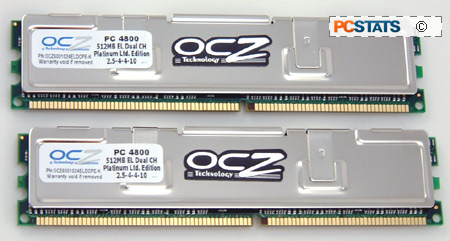Memory prices have fallen dramatically over the last six
months. These days it is not uncommon to find a generic stick of 512MB
PC3200 DDR memory for about $60 CDN. Yet over the same time period, enthusiast-calibre memory has not fallen in price much, unfortunately.
Take for example OCZs PC4800 Dual-Channel Platinum Limited Edition kit
of two 512MB sticks of DDR. Aimed directly at the performance user, these
puppies have a retail price of $330 CDN ($265 US). Quite expensive
compared to the average stuff that's on the market, but by default this
DDR is rated to run at an amazing 300 MHz with 2.5-4-4-10 memory
timings (at 2.85V)! The
timings are pretty quick, but
not quite at the level of 2-2-5. Still, DDR600 is definitely an impressive feat and tight timings are not as important to the
AMD Athlon64 as they are to Intel Pentium 4 systems.
OCZ present its PC4800 DC Platinum LTD Ed memory in jackets
of nickel-plated copper heatspreaders. Realistically, heatspreaders
don't do much for cooling at lower speeds/voltages, but they do a good job at
protecting the memory from physical damage. If you plan to really overclock your
memory, its also generally advisable to actively cool the DIMMs with a small
fan.
 |
|
OCZ PC4800 DC Platinum LTD ED |
|
|
 | |
Overclocking to DDR600
Levels
Before we began to push the OCZ PC4800 DC Platinum LTD Ed
memory modules, I first lowered the CPU multiplier to 6x; this way the CPU will
not be the bottleneck holding the memory back. If you haven't guessed, I'm a
low latency freak and I was
interested in seeing how high the PC4800 DC Platinum LTD Ed memory would run
with 2-2-2-5 memory timings.
Starting at stock speeds with a voltage of 2.6V, I increased the motherboard
speed in ~5 MHz increments. The first blip hit at 221 MHz; at that speed, the memory
started to become unstable and would often drop back to desktop while running
3D applications.
 |
| Overclocking Results: |
|
|
Increasing the memory voltage moderately to 2.8V solved those
issues and I continued to push the memory further. With tight timings, the OCZ
PC4800 DC Platinum LTD Ed finally topped out at a very respectable 234 MHz.
Increasing voltages (up to 3.8V) did not garner higher stable speeds but still,
234 MHz with 2-2-2-5 timings at 2.8V is very good!
Lowering the timings
all the way down to 2.5-4-4-10 (the memory's default) I continued going up from 234
MHz with 2.8V. Amazingly, the memory simply flew at these settings and the
PC4800 DC Platinum LTD Ed easily hit its default
rated speed of 300 MHz! Moving past 300 MHz, the memory seemed to have more life
in it and eventually settled down at 318 MHz. Anything higher and the
system would occasionally drop back to desktop while running 3D applications. Still.... 318MHz!
For testing purposes we're going to make an exception to
our standard of running overclocking tests with low latencies, and run the OCZ PC4800 DC Platinum LTD
Ed overclocking benchmarks at 318 MHz with lax timings.
 |
| pcstats test system
specs: |
| processor:
|
amd athlon64 4000+ |
| clock
speed: |
12 x 200 mhz = 2.4 ghz
8 x 316 mhz = 2.52 ghz |
| motherboards: |
dfi lanparty nf4 sli-dr (nf4-sli) |
| videocard: |
msi rx800xt-vtd256e |
| memory: |
2x 512mb corsair twinx3200xl pro
2x 512mb centon
gemini pc3200
2x 512mb ocz pc4000 gold dc vx
2x 512mb ocz
pc4800 platinum dc ltd ed |
| hard drive:
|
74gb western digital raptor |
| cdrom: |
gigabyte go-w0808a dvd burner |
| powersupply: |
pc power & cooling turbocool 510 sli |
| heatsink: |
prometeia mach ii gt (review) |
| Software
Setup |
WindowsXP
Forceware NF4 6.53
Catalyst 5.4 |
| Benchmarks
|
Business Winstone 2004
SiSoft Sandra
2005
PCMark04
3DMark2001SE
3DMark05
X2: The
Threat
UT2003
UT2004
Doom
3 | |
Note: We could not get the 7.5x multiplier working for this test, every time it was selected the
system would not boot.
PCSTATS Test
Methodology
PCSTATS tests DDR memory on AMD
Athlon64 systems only because Intel is still in the middle of moving its
platforms over to DDR2. Enthusiasts usually keep to the bleeding edge, so fast
DDR memory is useless for the Intel overclocker looking for more
juice.
On AMD test systems we're only interested in seeing how
high we can go with the memory running 1:1, as running with other dividers puts
the overclocking bottleneck elsewhere, not with the system memory. We usually
run DDR RAM latency at 2-2-2-5, or the memory's tightest possible timings, as
quick access is important to the CPU design. However in cases where memory is
built to run at high speeds with lax memory timings, we will run the benchmark
tests at manufacturer spec. Not doing so would put high speed DIMMs at a
disadvantage since the memory was not designed to run at tight memory timings.
Let's get started!

